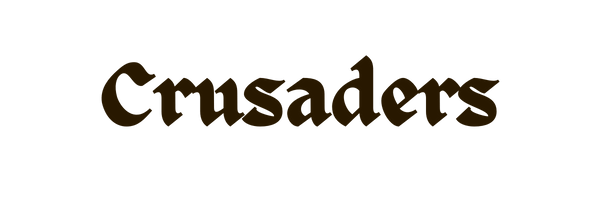Low Magic Setting Rules
Crusaders TTRPG ruleset for low magic setting games where magic may be more rare. Adapt the ruleset for low magic settings like Game of Thrones, Tolkein's Lord of The Rings, and more.
Low magic settings are fantasy worlds where magic exists but is rare, subtle, and often limited to a few individuals or specific circumstances. In these settings, the focus is more on realistic, gritty elements such as political intrigue, war, and personal struggles, with magic playing a minimal or behind-the-scenes role. The presence of magic is typically met with awe, fear, or suspicion, and it is not a common part of everyday life for most inhabitants. This creates a more grounded and relatable atmosphere compared to high magic settings where magic is ubiquitous and powerful.
Low Magic Base Rules
Crusaders TTRPG is built on a high fantasy high magic premise. That doesn't mean you can't adapt the rules to fit your setting.
Establishing Magic Rules:
In Lord of the Rings fantasy, magic is limited to items and magic users such as elves and wizards and require a casting focus.
Example LOTR rules:
Spells and effects are more subtle, for example a spell that would summon a giant Phoenix visage doesn't make a lot of sense in this setting but a giant boulder or fireball would be appropriate.
- All damage is halved.
- Movement speed enhancing effects are halved
- Armor Class cap is reduced by 5 per Tier
- Starting attributes are reduced from 32 to 24
- Magic is reduced to Elemental magic only.
- Otherworldly damage is changed to physical or Elemental.
Example Low Magic Settings You Might Run In Your Games
Middle-earth (J.R.R. Tolkien's The Lord of the Rings)
- While magic exists in Middle-earth, it is subtle and often tied to specific characters like Gandalf, Saruman, or the Elves. The world itself is more grounded, with magic not being a common part of everyday life for most inhabitants.
Westeros (George R.R. Martin's A Song of Ice and Fire)
- The world of Westeros is primarily focused on political intrigue and war, with magic being rare and often feared. Instances of magic, such as Melisandre's abilities or Bran's warging, are exceptional rather than commonplace.
The First Law Trilogy by Joe Abercrombie
- This series is set in a grim, realistic world where magic exists but is rare and feared. The plot revolves around characters caught in brutal wars and political schemes. Magic, when it appears, is powerful but comes with significant costs and consequences, making it a seldom-used force.
Race Restriction Examples For Low Fantasy
First Law Trilogy Race Examples
Humans are the primary inhabitants of the world, covering a wide range of cultures and regions.
Dwarves are known for their craftsmanship and resilience.
Elves could be adapted to the mysterious and ancient peoples.
Forest Gnomes are adapted to hidden, secretive societies within the forests.
Half Orcs could represent a brutish, marginalized people.
Halflings are known for their resourcefulness and agility.
Hobgoblins are militaristic and disciplined, fitting into the brutal world.
Orcs are ferocious and warlike, fitting into the harsher aspects of the setting.
Reptilians could be adapted to the more exotic, possibly isolated cultures.
Saurials are a primitive, tribal race that fits with the setting's rugged nature.
Shades could be adapted to represent beings tied to dark magic or mysterious origins.
Sylvanborn are nature-connected people fitting well with the world's wilderness.
Tieflings are adapted to have a more demonic or cursed background.
Trolls are large, brutish beings fitting into the world's darker corners.
Zombies could be used to represent reanimated beings tied to dark magic.
Less Suitable Examples
Arborians could be adapted to a race with deep connections to forests and nature.
Gargoyles could be adapted as a race of stone-like beings, possibly fitting into ancient ruins.
Harpies are winged creatures fitting into isolated, rocky regions.
Marrowfolk are a bone-themed race, possibly adapted to dark magic or necromancy.
Pandaren could be adapted to a unique, isolated culture.
Undines are water-connected beings, fitting into coastal or river settings.
Vanara are monkey-like beings, adapted to an exotic, jungle-like culture.
LOTR Race Examples
Dwarves are known for their craftsmanship, mining skills, and warrior spirit. They live in strongholds under mountains and have a rich history of conflict and alliance with other races.
Elves are one of the oldest races in Middle-earth, known for their grace, immortality, and powerful magic. They live in beautiful, hidden realms and are often involved in the great events of the world.
Goblins are malevolent creatures often found serving dark forces. They are cunning and numerous, posing a constant threat to the free peoples of Middle-earth.
Half Orcs could be adapted as a rare and intriguing race, possibly with a backstory of mixed heritage, struggling to find their place in the world.
Known as Hobbits in Middle-earth, Halflings are central to many of Tolkien's stories. They are small, peaceful, and have an unexpected bravery.
Humans are the most populous race in Middle-earth, with diverse cultures and kingdoms. They play crucial roles in the unfolding events of the world.
Orcs are central antagonists in Tolkien's works, serving the dark lords with brute strength and relentless aggression.
Sylvanborn are nature-connected people fitting well with the world's wilderness.
Trolls are large, fearsome creatures often found serving dark forces. They are powerful and dangerous foes.
Game of Thrones Race Examples
The most common race, with various cultures like Northmen, Dornish, and Ironborn.
Fits well as a race with a distinct culture, potentially similar to the mountain clans or skilled craftsmen.
While not traditionally part of the lore, they could be introduced as a mysterious and ancient race, akin to the Children of the Forest.
Similar to the Children of the Forest, living in harmony with nature.
Tinkers and inventors, possibly living in secluded communities.
Could be used as a rare, underground-dwelling race.
Could be introduced as a barbarian or warrior race, perhaps from Essos or beyond the Wall.
Similar to the hobbits of Tolkien, they could be a rare, reclusive race.
Similar to goblins but more organized and militaristic.
Could be used as a barbarian or warrior race, possibly from the far reaches of Essos.
Could be introduced as a rare, mythical race from distant lands.
Could be introduced as a mystical race, possibly animated statues from ancient ruins.
Fits well with the mythological aspects of the setting, similar to the harpies of Slaver's Bay.
Fits well within the lore, possibly similar to the giants beyond the Wall.
Could be introduced as a rare, ancient undead race, possibly from the Shadow Lands or beyond.
Similar to the wights raised by the White Walkers.
Class Restriction Examples For Low Fantasy
Casters
Bard
Enchanter
Luckweaver
Royalty
Mage
Blood Mage
Key Mage
Untamed Mage
Wizard
Cleric
Athiest
Life
Unity
Evoker
Lorekeeper
Spellbreaker
Wyrmguard
Hybrid
Shifter
Lycan
Spirit
Kitsune
Shaman
Bender
Totem
Witch Doctor
Tinkerer
Edgestrike
Gastronomic
Mad Scientist
Techno
Tracker
Mercenary
Wildheart
Witch Hunter
Melee
Duelist
Archeologist
Brawler
Swift Shot
Vanguard
Guardian
Paladin
Valkyrie
Valor Knight
Rogue
Assassin
Infiltrator
Ninja
Titan
Colossus
Juggernaut
Reckoner





